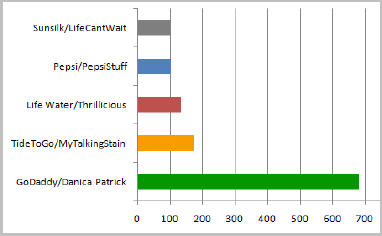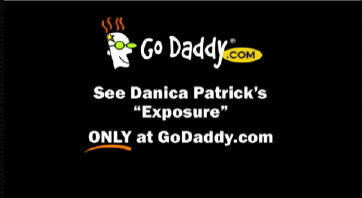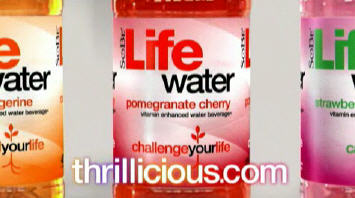-
A Little More Super Bowl Fun
OK, today no rant, just one more little insight to offer from Super Bowl ads.
Yesterday I highlighted the 5 ads (out of the total 52) which had a broadband component. They were:
GoDaddy - promoting Danica Patrick's "Exposure" banned ad and other videos
TideToGo - promoting "MyTalkingStain.com" a fun microsite
SoBe LifeWater - promoting "Thrillicious.com" a microsite where 2 more spots with the dancing lizards can be seen
Sunsilk - promoting "LifeCantWait.com", a microsite with a UGC contest which is not yet active
Pepsi - promoting "PepsiStuff.com", where users can download videos and music
I'm able to track click-throughs to each link I share in these emails. I thought you might be interested to see a graph of these clicks from yesterday. Note they're shown as an index, not actual numbers, with a starting index value of 100 for Sunsilk.

As you can see, VideoNuze email recipients expressed a pretty strong interest in the GoDaddy.com Danica Patrick ad. I'm sure many of you are not surprised since it has a pretty overt potential payoff for visitors.
Though the specifics of that payoff (is Danica actually going to remove her jacket and expose herself?) are very enticing, I think the larger issue to pay attention to is: how can advertisers explicitly use suspense, uncertainty and payoff to drive audiences to do something? Here's the last frame of the Danica spot:

To make this more tangible, consider this: The SoBe LifeWater ad was easily the most impressive use of special effects of all the Super Bowl ads. No doubt the SoBe LifeWater folks spent heavily making the ad, and then paying supermodel Naomi Campbell to dance with the pack of lizards to Michael Jackson's "Thriller." It certainly qualifies as the kind of thing that people would be interested in seeing more of, had SoBe LifeWater teased fans the right way at the end of the ad.
But they didn't. Instead, they simply flashed the URL "Thrillicios.com" at the end of the spot. Nothing was said about what to expect there, why you should go there, what surprises were in store, etc. (In fact there are 2 very funny and clever "episodes". And by the way, does this imply a new Life Water iguana series? Who knows?). Here's the last frame of the SoBe spot:

The point is this: I think SoBe LifeWater missed a huge opportunity to keep viewers engaged, which would have both improved the ROI on their Super Bowl ad spend, and also deepened viewers' engagement with the brand. While the Campbell spot was hugely entertaining, it did little to power ongoing engagement. Contrast this with GoDaddy, which no doubt had people pouring into its web site since the spot ran, with ongoing chatter and brand-building taking place.
As I said yesterday, advertisers need to understand how to use broadband video to evolve Super Bowl ads from having big-time entertainment value to having big-time engagement value. Some like GoDaddy get this, while many others, like SoBe LifeWater, are still on the learning curve.
What do you think? Post a comment and let us know!Addendum - I missed this piece in AdAge "GoDaddy Super Bowl Spot Sets Web-Traffic Record." The "Exposure" on-air ad drove 2 million visits to the site, during the game alone, a record for GoDaddy since it began advertising on the Super Bowl. And no doubt a multiple of that since the game ended. More evidence that GoDaddy nailed it big-time.Categories: Brand Marketing, Sports
Topics: GoDaddy, Life Water, Pepsi, Sunsilk, Super Bowl, TideToGo
-
My Rant About Super Bowl Ads
I love the Super Bowl ads as much as anyone. I never stop being amazed by the creativity and humor on display during each year's big game. This year was no exception: screeching squirrels, a strutting heart,
 shrunken heads, talking babies, the list goes on. For what Super Bowls ads are and always have been, they're terrific. My problem is that I believe broadband video allows Super Bowl ads to be much more than what they are and always have been. But the agency world does not seem to be getting this message.
shrunken heads, talking babies, the list goes on. For what Super Bowls ads are and always have been, they're terrific. My problem is that I believe broadband video allows Super Bowl ads to be much more than what they are and always have been. But the agency world does not seem to be getting this message.Two years ago I wrote "The Ten Million Dollar Super Bowl Ad?", where I outlined a scenario under which a 30 second spot could someday go for ten million bucks. How? By combining the best of brand advertising (the big emotional play) with the best of online advertising (the big measurable, performance-oriented play).
I wrote in that post: "What I envision is that the 30-second spot during the game will become the viewer's introduction or re-introduction to the brand or product. Numerous online, broadband-centric tactics will follow, with video being the center of the action. In football terms, the 30-second spot will morph from throwing a long pass (which is accompanied by high drama, but low probability of an actual score) to executing a more consistent ground game (accompanied by lower drama, but a much higher probability of an actual score). With this added measurability and a direct feedback loop, marketers will have much less anxiety about whether to ante up for the big game (and therefore the price will spiral upward).
I thought agencies and marketers would see this light and rush toward it. Boy was I over-optimistic. After watching all 52 Super Bowl ads this morning (thanks AOL), I am completely dismayed to report that, by my count, only 5 ads had any broadband video component:
GoDaddy - promoting Danica Patrick's "Exposure" banned ad and other videos
TideToGo - promoting "MyTalkingStain.com" a fun microsite
Life Water - promoting "Thrillicious.com" a microsite with a 2nd spot with the dancing iguanas
Sunsilk - promoting "LifeCantWait.com", a microsite with a UGC contest which is not yet active
Pepsi - promoting "PepsiStuff.com", with Amazon (ok, more focused on music than video)
All of the other 47 ads, representing tens of millions of dollars of clients' money, followed the same game plan from Super Bowls' past: go for either the clever, the funny or the gross, in an attempt to create buzz and fond memories for fans.
For me, this hidebound behavior showcases agencies at their most disappointing: unable to break out of the box, recognize new consumer engagement opportunities for their clients or embrace new technologies. Their inability or unwillingness to be more progressive is at the heart of why the whole advertising industry is in such chaos, with an increasing share of total spending shifting to online each year.
Nonetheless, I remain a long-term optimist. Maybe I'm crazy, but I'm still betting that someday, somehow, more agencies and brands will wake up and realize what the 5 brands above did this year: the combination of on-air and broadband is how to score a touchdown.
What do you think? Post a comment and let us all know!
Categories: Advertising, Sports
Topics: GoDaddy, Life Water, Pepsi, Sunsilk, Super Bowl, TideToGo
Posts for 'TideToGo'
|


